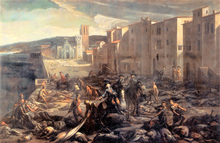François Chicoyneau
François Chicoyneau (born April 23, 1672 in Montpellier , † April 13, 1752 in Versailles ) was a French doctor and councilor of state.
Live and act
François Chicoyneau was born as the second child of the doctor and chancellor of the University of Montpellier Michel Chicoyneau. He was initially designated by his father for service in the Navy. After the early death of the first son - Michel-Aimé (1670–1690) - and the third son Gaspard († 1692) - whom he had designated as the bearer of his inheritance, the father decided that François would take over this function and for this purpose Should study medicine. On March 10, 1693 he received the medical doctorate in Montpellier. Very soon he was Chancellor of the Montpellier Medical School. His name opened the gates of the royal court for him and so in 1731 he became a doctor of the royal children and in 1733, as the successor to his father-in-law Pierre Chirac , the king's first doctor , who made him Baron de Lavalette. The position as royal personal physician also brought Chicoyneau the rank and title of councilor of state. In 1732 he became a member of the Académie des Sciences .
Treatment of syphilis
With regard to the treatment of syphilis, Chicoyneau criticized the uselessness and danger of large internal mercury doses and instead recommended external rubs in small amounts and at large intervals.
Plague in Marseille in 1720
On the recommendation of Pierre Chirac, François Chicoyneau was sent to Marseille in 1720, where a plague epidemic had broken out. Faculty professor Antoine Déidier († 1746) and doctor Jean Verny (1657–1741) accompanied him from Montpellier. The doctors Jean-Baptiste-Nicolas Boyer (1693-1768) and Joseph-Guichard Duverney (1648-1730) were seconded from Paris. In agreement with Pierre Chirac, François Chicoyneau denied that the disease could be transmitted. Jean Astruc argued, however, that the disease was brought in by a ship coming from the Orient and that it was therefore inevitable that coercive measures were used. He could not assert himself against Pierre Chirac, who doubted the contagiousness of the disease and advised the government to refrain from quick and strict isolation measures.
Works
-
An ad curandam luem veneream frictiones mercuriales in hanc finem adhibendae ut salivae fluxus concitetur? Montpellier 1718
- An analytical inquiry into the specifick property of mercury, relating to the cure of venereal diseases. Wherein is explained, I. The nature ... and choice of preparations. II. The necessary cautions ... III. The true generation and nature of the virus. IV. The variety of its symptoms in different climates ... V. The ill consequences of a bad practice ... VI. An answer is given to several objections ... VII. Chicanneau's method of curing this distemper without salivation is vindicated… . London 1732 (digitized version)
-
Observations et réflexions propres à confirmer ce qui est avancé par Mrs Chicoyneau, Verny et Soulier dans la relation du 10 December 1720 touchant la nature, les événements et le traitement de la peste de Marseille . Claude-Gilles Lecamus, Toulouse 1721 (digitized version )
- Johann Jacob Scheuchzer (translator). From the Martian Plague . Bodmer, Zurich 1721 (digitized version)
- Report of the plague at Marseilles: the coincidences, premeaning and cure, as well as the bumps and twinkles / given out by the Doctores sent from the French court to Marseilles: Chicoyneau, Verny and Soullier. According to the copy, it was printed at Marseilles on the orders of Mr. Commandanten, Ober-Meyers and Schöppen of said city . Haller and Comp., Bern 1721 (digitized version)
- A succinct account of the plague at Marseilles: its symptoms, and the methods and medicines used for curing it . London 1721 (digitized version)
- Together with Jean-Baptiste Sénac . Traité des causes, des accidens, et de la cure de la peste: avec un recueil d'observations et un détail circonstancié des précautions qu'on a price pour subvenir aux besoins des peuples affligés de cette maladie, ou pour la prévenir dans les lieux qui en sont menacés. PJ Mariette, Paris 1744 (digitized version)
literature
- Jean-Paul Grandjean de Fouchy. Éloge de M. Chicoyneau , dans Histoire de l'Académie royale des sciences - Année 1752 , Imprimerie royale, Paris, 1756, pp. 153-164 (digitized version )
- Jean Astruc. Mémoires Pour Servir à L'Histoire De La Faculté De Medecine De Montpellier. G. Cavelier, Paris 1767, pp. 289–291 (digitized version )
- Dictionnaire des sciences médicales. Biography médicale. Volume 3, Panckoucke, Paris 1821. pp. 243–244 (digitized version )
- Amédée Dechambre . Dictionnaire encyclopédique des sciences médicales . Volume 16, G. Masson and P. Asselin, Paris 1874. P. 16 (digitized version)
- Ernst Julius Gurlt and August Hirsch . Biographical lexicon of the outstanding doctors of all times and peoples. Volume II, Urban & Schwarzenberg, Vienna and Leipzig 1885, pp. 10–11 (digitized version)
Individual evidence
- ↑ Henry J.-G. de Milleville: Armorial historique de la Noblesse de France , Paris 1845, p. 142
- ↑ Germain Pichaut de La Martinière: Considérations d'un médecin de Montpellier , 1740, p. 9
- ^ List of members since 1666: Letter C. Académie des sciences, accessed on October 29, 2019 (French).
- ↑ Jean Astruc. Dissertation on l'origine des maladies épidémiques et principalement sur l'origine de la peste, où l'on explique les causes de la propagation et de la cessation de cette maladie. Jean Mertei, Montpellier 1721 (digitized version )
Web links
| personal data | |
|---|---|
| SURNAME | Chicoyneau, François |
| BRIEF DESCRIPTION | French doctor |
| DATE OF BIRTH | April 23, 1672 |
| PLACE OF BIRTH | Montpellier |
| DATE OF DEATH | April 13, 1752 |
| Place of death | Versailles |


